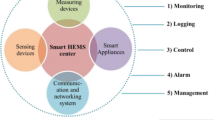Abstract
The BECMP (building energy consumption monitoring platform) is a valuable tool that can bring about a remarkable improvement in terms of energy conservation. With the growth in scale and use BECMP, data packet loss is becoming an ever-increasing and more serious problem. Large-scale BECMPs are typically configured using a hierarchical structure, making it susceptible to problems such as congestion and packet loss due to malfunctions in the link layer. These problems lead to a loss in efficiency of maintenance, thus eroding the gains realized by BECMP. In this paper, a decentralized and self-organized network structure is proposed. Rather than a hierarchical structure, a flat topology is implemented to improve robustness and the efficiency of data transmission. A corresponding routing strategy based on the minimum spanning tree algorithm has been developed and validated. Simulation results have shown that the proposed network is able to adapt to interference within the network and achieve a better overall performance.
Similar content being viewed by others
References
Avonts J, Blondia C (2016). A framework to compare topology algorithms in multi-channel multi-radio wireless mesh networks. Computer Networks, 98: 89–108.
Chai Y, Shi W, Shi T (2017). Load-aware cooperative hybrid routing protocol in hybrid wireless mesh networks. AEU-International Journal of Electronics and Communications, 74: 135–144.
Dimoudi A, Kostarela P (2009). Energy monitoring and conservation potential in school buildings in the C’climatic zone of Greece. Renewable Energy, 34: 289–296.
Dong B, Yan D, Li Z, Jin Y, Feng X, Fontenot H (2018). Modeling occupancy and behavior for better building design and operation—A critical review. Building Simulation, 11: 899–921.
Faruqui A, Sergici S, Sharif A (2010). The impact of informational feedback on energy consumption—A survey of the experimental evidence. Energy, 35: 1598–1608.
Fernandes LL, Lee ES, Di Bartolomeo DL, McNeil A (2014). Monitored lighting energy savings from dimmable lighting controls in The New York Times Headquarters Building. Energy and Buildings, 68: 498–514.
Fu Y, Li Z, Feng F, Xu P (2016). Data-quality detection and recovery for building energy management and control systems: Case study on submetering. Science and Technology for the Built Environment, 22: 798–809.
Gershenfeld N, Samouhos S, Nordman B (2010). Intelligent infrastructure for energy efficiency. Science, 327(5969): 1086–1088.
Jain RK, Taylor JE, Peschiera G (2012). Assessing eco-feedback interface usage and design to drive energy efficiency in buildings. Energy and Buildings, 48: 8–17.
Kim SA, Shin D, Choe Y, Seibert T, Walz SP (2012). Integrated energy monitoring and visualization system for Smart Green City Development: Designing a spatial information integrated energy monitoring model in the context of massive data management on a web based platform. Automation in Construction, 22: 51–59.
Li S, Liu GP (2016). Networked predictive control for nonlinear systems with stochastic disturbances in the presence of data losses. Neurocomputing, 194: 56–64.
Lin YH, Tsai MS (2015). The integration of a genetic programmingbased feature optimizer with fisher criterion and pattern recognition techniques to non-intrusive load monitoring for load identification. International Journal of Green Energy, 12: 279–290.
Liu GP (2010). Predictive controller design of networked systems with communication delays and data loss. IEEE Transactions on Circuits and Systems II: Express Briefs, 57: 481–485.
Polzin T, Daneshmand SV (2003). On steiner trees and minimum spanning trees in hypergraphs. Operations Research Letters, 31: 12–20.
Enríquez R, Jiménez MJ, Heras MR (2017). Towards non-intrusive thermal load monitoring of buildings: BES calibration. Applied Energy, 191: 44–54.
Rakkiyappan R, Dharani S, Cao J (2015). Synchronization of neural networks with control packet loss and time-varying delay via stochastic sampled-data controller. IEEE Transactions on Neural Networks and Learning Systems, 26: 3215–3226.
Saglam A, Baykan NA (2017). Sequential image segmentation based on minimum spanning tree representation. Pattern Recognition Letters, 87: 155–162.
Tuteja A, Gujral R, Thalia S (2010). Comparative performance analysis of DSDV, AODV and DSR routing protocols in MANET using NS2. In: Proceedings of International Conference on Advances in Computer Engineering, Bangalore, India, pp. 330–333.
Zhao L, Zhang J, Liang RB (2013). Development of an energy monitoring system for large public buildings. Energy and Buildings, 66: 41–48.
Zhao L, Zhang J (2015). Research on the data transmission optimization for building energy consumption monitoring system based on fuzzy self-adaptation method. Energy, 93: 1385–1393.
Acknowledgements
This work is supported by the National Key Research and Development Project of China (No. 2017YFC0704107).
Author information
Authors and Affiliations
Corresponding author
Rights and permissions
About this article
Cite this article
Yu, H., Zhang, J. & Liang, R. Development of a self-organized network to optimize the data transmission in BECMP based on minimum spanning tree algorithm. Build. Simul. 12, 535–545 (2019). https://doi.org/10.1007/s12273-018-0503-3
Received:
Revised:
Accepted:
Published:
Issue Date:
DOI: https://doi.org/10.1007/s12273-018-0503-3




